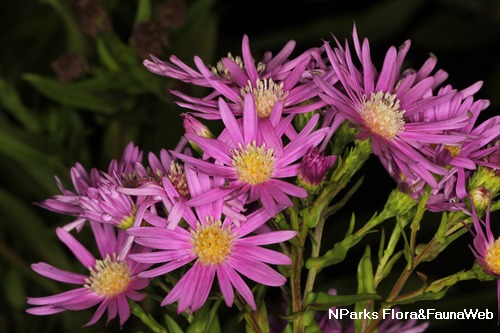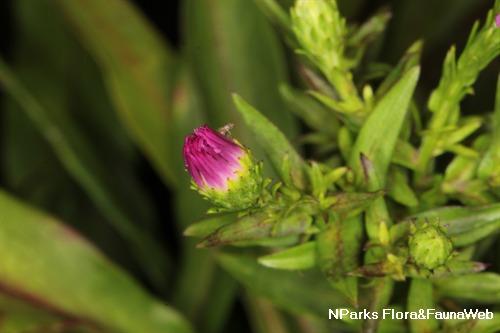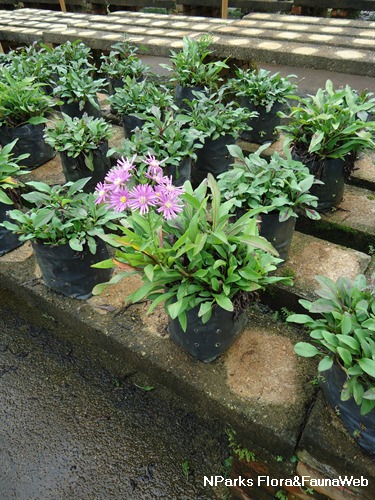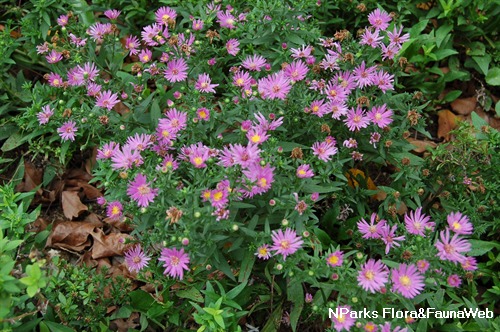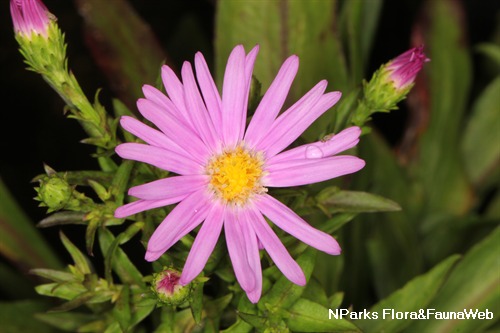
Back
Symphyotrichum laeve (L.) Á. Löve & D. Löve var. laeve
| Family Name: | Asteraceae (Compositae) |
| Synonyms: | Aster laevis var. laevis, Aster laevis |
| Common Name: | Smooth Aster, Smooth Blue Aster |
Name
Classifications and Characteristics
| Plant Division | Angiosperms (Flowering Seed Plants) (Dicotyledon) |
|---|---|
| Plant Growth Form | Herbaceous Plant, Creeper |
| Lifespan (in Singapore) | Perennial |
| Mode of Nutrition | Autotrophic |
| Maximum Height | 0.6 m to 1.2 m |
Biogeography
| Native Distribution | Canada, Eastern and Central USA |
|---|---|
| Native Habitat | Terrestrial |
| Preferred Climate Zone | Tropical, Temperate |
| Local Conservation Status | Non-native |
Description and Ethnobotany
| Growth Form | Herbaceous, perennial flowering plant that has both a rhizome (an underground, horizontal stem from which new shoots emerge) and a caudex (the underground portion of the vertical stem which also gives rise to new shoots). |
|---|---|
| Foliage | Alternate leaves are thick and lanceolate (1 - 2.4 cm wide, 5 - 12 cm long). Younger leaves are typically sessile with entire leaf margins. Older leaves usually clasp the stem and have serrate leaf margins. |
| Stems | Herbaceous stem typically lacks hairs. |
| Flowers | Unscented, composite flowers (1.7 - 2.5 cm) consist of 15 - 30 light purple ray flowers (having petal-like structures) and yellow disk flowers (occurring in the center). Plants produce an abundance of flowers. |
| Fruit | Fruits are classifed as achenes which are dry and one-seeded. The fruits are smooth and they usually have a light brown to reddish pappus (downy appendage). |
| Habitat | It occurs in a variety of habitats: thickets, savannas, dry mixed or tallgrass prairies, mesic black soil or loess hill prairies, and roadsides. It is also found in the understory of deciduous forests dominated by quaking-aspen, openings within sandy or upland forests, or along forest margins. It is found at altitudes of up to 1000 m. |
| Cultivation | Plant in well-drained, fertile loamy soil or clay loam. During the first 12 weeks of growth, feed the plants with a 20-10-20 NPK liquid fertilizer at 100 ppm concentration. Thereafter, apply a 10-20-10 NPK liquid fertilizer at 200 ppm. After fertilizing, rinse any residue off the leaves. This species is susceptible to powdery mildew and diseases that affect the foliage. It grows well alongside of Helianthus and Solidago spp.. It should not be planted next to aggressive, taller plants, as it is likely to be outcompeted. Propagate by seed, stem cuttings or rhizome division. Seeds should be planted at a depth equal to seed length (about 1.5 cm). Seeds collected at higher elevations should by cold-stratified for 2.5 to 4 months by moistening the seeds and incubating at 1 - 2 degrees Celsius. |
| Etymology | The genus "Symphyotrichum" refers to how the thin, petal-like structures of the ray flowers resemble hairs. It comes from 2 Greek words, "symphyos" which means growing next to each other and "thrix" meaning hair. The specific epithet "laeve" means smooth. The common name "Aster" comes for a Greek word that means star, referring to the flowers' resemblance to stars. |
Landscaping Features
| Desirable Plant Features | Ornamental Flowers |
|---|---|
| Landscape Uses | Parks & Gardens, Flowerbed / Border, Container Planting |
Fauna, Pollination and Dispersal
| Fauna Pollination Dispersal Associated Fauna | Butterfly-Attracting (Flower Nectar) |
|---|---|
| Pollination Method(s) | Biotic (Fauna) |
Plant Care and Propagation
| Light Preference | Full Sun, Semi-Shade |
|---|---|
| Water Preference | Lots of Water |
| Rootzone Tolerance | Moist Soils, Well-Drained Soils, Fertile Loamy Soils |
| Propagation Method | Seed |
Foliar
| Foliage Retention | Deciduous |
|---|---|
| Mature Foliage Colour(s) | Green |
| Foliar Attachment to Stem | Sessile |
| Foliar Shape(s) | Non-Palm Foliage (Lanceolate) |
| Foliar Venation | Pinnate / Net |
| Leaf Area Index (LAI) for Green Plot Ratio | 4.5 (Shrub & Groundcover - Dicot) |
Non - Foliar and Storage
| Stem Type & Modification | Caudex |
|---|
Floral (Angiosperm)
| Flower Colour(s) | Purple |
|---|---|
| Flower Texture(s) | Smooth |
| Flower Grouping | Cluster / Inflorescence |
Fruit, Seed and Spore
| Fruit Classification | Simple Fruit |
|---|
Image Repository
Others
| Master ID | 405 |
|---|---|
| Species ID | 1701 |
| Flora Disclaimer | The information in this website has been compiled from reliable sources, such as reference works on medicinal plants. It is not a substitute for medical advice or treatment and NParks does not purport to provide any medical advice. Readers should always consult his/her physician before using or consuming a plant for medicinal purposes. |

